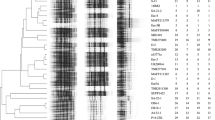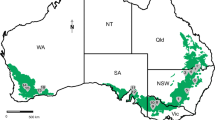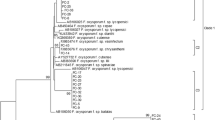Eighty-five Pyricularia isolates were collected from 29 host species of Gramineae, Bambusideae and Zingiberaceae plants sampled in Brazil, Uganda, Ivory Coast, India, Nepal, China, Indonesia and Japan. These isolates were compared on the basis of pathogenicity, mating ability and restriction fragment length polymorphisms with single-copy DNA probes. Based on the pathogenicity to eight differential gramineous plants, these isolates were classified into seven pathotypes: finger millet type, foxtail millet type, common millet type, rice type, crabgrass type, Italian ryegrass/ weeping lovegrass type, and non-cereal/grass type. Genetic variation among these isolates was assessed by RFLP analysis with two restriction enzymes and nine single-copy DNA probes isolated from a finger millet strain. An UPGMA dendrogram based on the RFLPs revealed that the 85 isolates could be classified into seven major groups. Isolates from cereal crops (finger millet, foxtail millet, common millet, wheat and rice) and a grass, Brachiaria plantaginea, were clustered into a single group. They were further divided into six subgroups corresponding to the pathotypes. Among cereal crop isolates only an isolate from pearl millet was located into a different group. The remaining isolates were clustered into five groups designated as the crabgrass group, the buffelgrass and jungle rice group, the rice cutgrass, knotroot bristlegrass and Setaria tomentosa group, the bamboo and bamboo grass group and the Zingiber mioga group. The isolates from cereal crops were generally capable of mating with finger millet strains and constituted a closed mating compatibility group. These results suggested that the isolates from cereal crops form a single group with a common ancestor although they are pathogenic to taxonomically diverse plants. A combined analysis of the pathogenicity and genetic similarity suggested that the transmission of M. grisea isolates occurs in natural agroecosystems between finger millet and Eleusine africana, goosegrass or Bambusa arundinacea, between foxtail millet and green bristlegrass, and between rice and tall fescue, Italian ryegrass, sweet vernalgrass, reed canarygrass or Oryza longistaminata.
Similar content being viewed by others
Author information
Authors and Affiliations
Additional information
Received 9 August 1999/ Accepted in revised form 12 November 1999
Rights and permissions
About this article
Cite this article
KATO, H., YAMAMOTO, M., YAMAGUCHI-OZAKI, T. et al. Pathogenicity, Mating Ability and DNA Restriction Fragment Length Polymorphisms of Pyricularia Populations Isolated from Gramineae, Bambusideae and Zingiberaceae Plants. J Gen Plant Pathol 66, 30–47 (2000). https://doi.org/10.1007/PL00012919
Issue Date:
DOI: https://doi.org/10.1007/PL00012919




